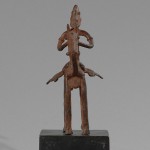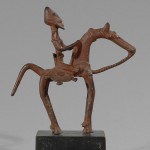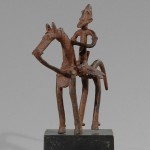NAK 0610-5 – SOLD
Equestrian, Dogon, Mali
H: 17 cm (6,7″), W: 7,5 cm (3″)
This Dogon Bronze Sculpture of a Horse and Rider was made by the Dogon people in Mali. The Dogon civilization dates to the 13th or 14th century. Objects from this period are quite rare. This figure is a funerary piece, buried with its owner, and as you can see from its appearance, it was dug from the ground and retains its archeological patina.
Dogon figures depicting horses and riders reflect the prestige and power surrounding an animal that has been associated with royalty since horses were introduced to West Africa more than a thousand years ago. Dogon equestrian figures are most often identified as images of the HOGON, since in Dogon society horses is a luxury generally reserved for rich and powerful people. “Horses appear in Dogon mythology about the creation of the world, and the horse has been interpreted as a blacksmith who represents NOMMO, or other mythological beings. According to DOGON CLIFF DWELLERS, by Imperato the horse was the first animal to leave the ark, in Dogon mythology, and symbolize chieftainship, power, and wealth.
This piece was crafted using lost wax methodology, which most likely made its way to western, sub-Saharan Africa from the Arab world, just like horses and Islamic beliefs. It is equally likely the owner of this figure was not a convert to Islam because of the prohibition on figurative art. It could very well be, albeit conjecture, that the owner of this piece was a trader or merchant of some sort, perhaps someone engaged in the remnants of the trans-Saharan trade, which persisted because of small population centers servicing the indigenous, tribal populations of the region.
Click here for more information about the Dogon people
Request price for Dogon Equestrian




